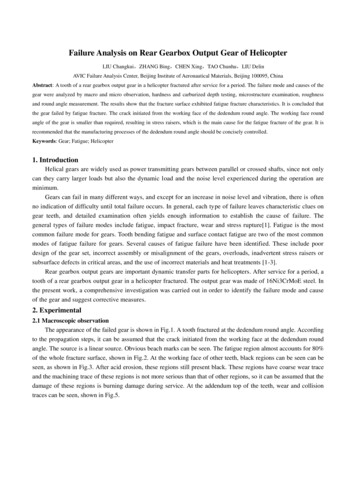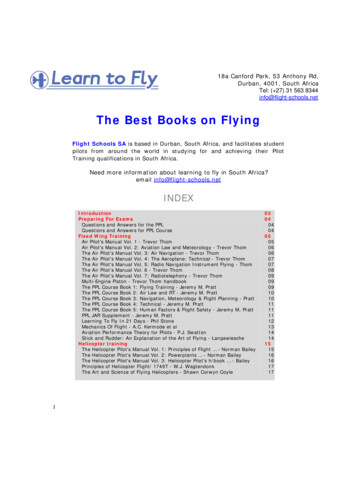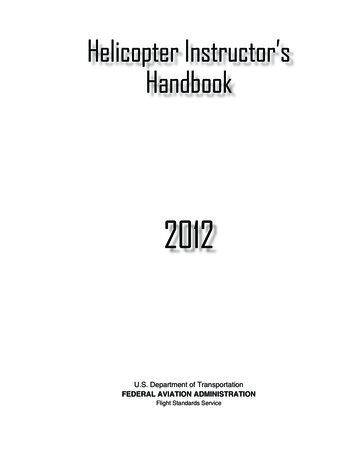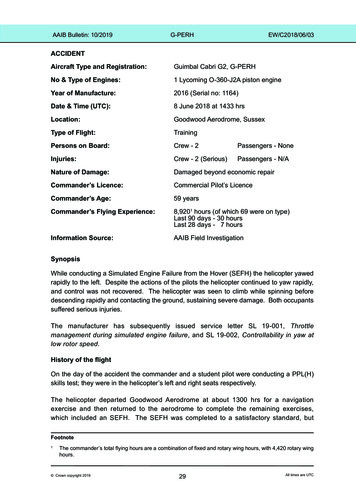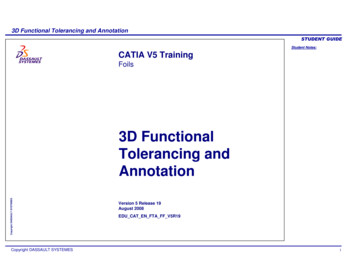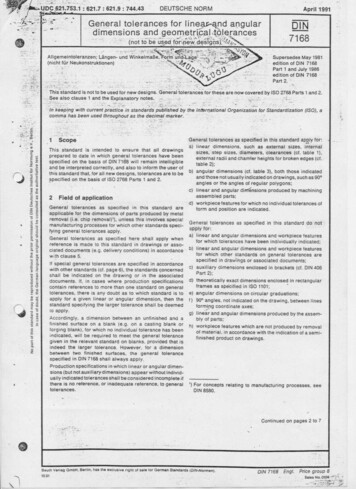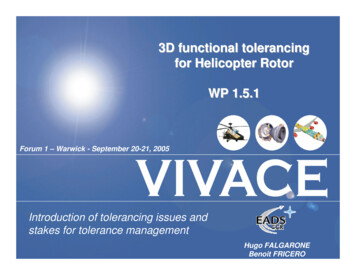
Transcription
3D functional tolerancingfor Helicopter RotorWP 1.5.1Forum 1 – Warwick - September 20-21, 2005Introduction of tolerancing issues andstakes for tolerance managementVIVACE FORUM 1 - Warwick 2004 VIVACE Consortium Members.All rights reservedPage: 1Hugo FALGARONESeptember 20-21, 2005Benoit FRICERO
Outlines Introduction Aerospace Tolerancing issues Tolerancing tools : State of the Art Comparison Methodology specifications ConclusionsVIVACE FORUM 1 - Warwick 2004 VIVACE Consortium Members.All rights reservedPage: 2September 20-21, 2005
IntroductionTolerance analysis Assembly simulation withmanufactured parts, ie partswith geometric variations.Manufacturing capability requirement :Continous trade off between cheap manufacturingprocess and high quality productFeatures relationship : Garantee Product functionsand assemblyHow to define these tolerances ?How to ensure tracability betweenfunction requirement and tolerance specification ?VIVACE FORUM 1 - Warwick 2004 VIVACE Consortium Members.All rights reservedPage: 3September 20-21, 2005
IntroductionFunctional tolerancing Vs Traditional dimensioningVIVACE FORUM 1 - Warwick 2004 VIVACE Consortium Members.All rights reservedPage: 4September 20-21, 2005
Aerospace Tolerancing IssuesManufacturing cost analysis for an aircraft structure :Assembly55%ManufacturingMaterials25%20%Improve product assemblability¾ Improve manufacturing capabilities¾ Improve tolerance management methodologiesfrom design offices to manufacturing Quality.¾ Use tools to support these methodologiesVIVACE FORUM 1 - Warwick 2004 VIVACE Consortium Members.All rights reservedPage: 5September 20-21, 2005
Aerospace Tolerancing IssuesTechnical data managed for tolerance analysis :¾Design requirements: Aerodynamic,Weight, Product functions Key characteristics Assembly constraints¾ Product geometrical definition : Digital Mock Up¾ Manufacturing capabilities¾ Assembly sequence or kinematic model of assembly process¾ 3D stack chain : List of contributing features for each requirementTolerance management is a multidisciplinary processVIVACE FORUM 1 - Warwick 2004 VIVACE Consortium Members.All rights reservedPage: 6September 20-21, 2005
Aerospace Tolerancing IssuesAssembly sequence impact :CCDBDBAANominal ModelModel with deviationsCDBCDBASequence A- D- B - CASequence A- B- C- DSequence is chosen regarding to product main functionsTolerance annotations include implicitly assembly sequenceVIVACE FORUM 1 - Warwick 2004 VIVACE Consortium Members.All rights reservedPage: 7September 20-21, 2005
Aerospace Tolerancing IssuesTolerance impact analysis :– How to understand specification for downstreamtolerance users : Manufacturing– How to impact design change on tolerancespecification ?VIVACE use Case : Non conformityOne dimension of a manufacturd part is out of toleranceÎ How to status on the associated risk ? Re-build tolerance analysis to find outjustification of tolerance specification. Deal with non conformity process even withoutDigital Mock Up ; Case of old programs still inproductionVIVACE FORUM 1 - Warwick 2004 VIVACE Consortium Members.All rights reservedPage: 8September 20-21, 2005
Tolerancing tools State of the artDifferent tools for different goals Kinematic tolerancingObjectiveWhenData needed Feature tolerancingObjectiveWhenData needed : Validate assembly of toleranced parts: Design validation: Complete geometry with GD&T, assembly sequenceFlexible tolerancingObjectiveWhenData needed : Validate design concepts and define frontier tolerances: early design stage: Rought geometry, Manufacturing capabilities, building philosophy (kinematic scheme): Simulate realistic assembly process: Design validation: FEM, DMU with GD&T, assembly sequenceTolerance editionObjectiveWhenVIVACE FORUM 1 - Warwick: Edit Geometrical Dimensional and Tolerancing annotations on DMU: DMU Publication (drawings) 2004 VIVACE Consortium Members.All rights reservedPage: 9September 20-21, 2005
Tolerancing tools : State of the art Kinematic tolerancingMecamasterAnaToleMecamaster SARLEADS CCR Feature tolerancing3DCSCeTOL6 SigmaTolerance ManagereMTolMateDCSSigMetrixPCO TechnologiesPCT Flexible tolerancingCATIA V5 – TAADassault Systemes Tolerance editionCATIA V5 – FTA & PFTAVIVACE FORUM 1 - Warwick 2004 VIVACE Consortium Members.All rights reservedDassault SystemesPage: 10September 20-21, 2005
Helicopter case studyRotor case studyMastEnd PlateRingScissorsObjective : Check the continous non-contact between thering and the end plateVIVACE FORUM 1 - Warwick 2004 VIVACE Consortium Members.All rights reservedPage: 11September 20-21, 2005
Helicopter case study Nominal Position Worst Case PositionPlane ContactEnd PlateBall JointMastScissorsMeasureRingCurrently, this computation is done with simplified 1D stack chain.VIVACE FORUM 1 - Warwick 2004 VIVACE Consortium Members.All rights reservedPage: 12September 20-21, 2005
Case studyTo simplify the demonstration, let’s use a demo case study easier to handle.Demo case study presentationaU1bU3U2cdefVariationsVIVACE FORUM 1 - WarwickMeasures 2004 VIVACE Consortium Members.All rights reservedPage: 13September 20-21, 2005
Tolerancing tools : State of the artMecamaster Technical Description–––– Kinematic modelling with liaisonCatia V5 VB integrationWorst case & statistical computationVariations are included in liaisonRemarks–––––Point based modeling ( no DMU necessary)No dynamic link with DMUNo translation of Tolerance annotationStatistical computation very limitedWell adapted for early tolerance analysisVIVACE FORUM 1 - Warwick 2004 VIVACE Consortium Members.All rights reservedPage: 14September 20-21, 2005
Tolerancing tools : State of the artMecamaster ModelingMeasuresaaefcb&dPositioning linkVIVACE FORUM 1 - Warwick 2004 VIVACE Consortium Members.All rights reservedPage: 15September 20-21, 2005
Tolerancing tools : State of the artAnaTole Technical Description–––– Kinematic modelling with liaisonCatia V5 CAA integrationWorst case & statistical computationVariations are included in liaisonRemarks––––––Point based modeling ( no DMU necessary)No dynamic link with DMUNo translation of Tolerance annotationGood over constraints systems analysisStatistical computationWell adapted for early tolerance analysisVIVACE FORUM 1 - Warwick 2004 VIVACE Consortium Members.All rights reservedPage: 16September 20-21, 2005
Tolerancing tools : State of the artAnatole ModelingPositioning linkMeasuresVIVACE FORUM 1 - Warwick 2004 VIVACE Consortium Members.All rights reservedPage: 17September 20-21, 2005
Tolerancing tools : State of the artCeTol 6sigma Technical Description––––– Kinematic modelling with liaisonAssembly graph modellingCatia V5 CAA integrationWorst case & statistical computationTake into account of geometricaltolerancesRemarks––––Friendly graphic user interfaceFeatures based modeling ( DMU necessary)over-constraints systems visualisationlack of visualization of the model over the productVIVACE FORUM 1 - Warwick 2004 VIVACE Consortium Members.All rights reservedPage: 18September 20-21, 2005
Tolerancing tools : State of the artCeTol 6sigmaTolerancePositioning link– This graph shows the degrees offreedom of each part and link– It becomes hard to handle withcomplex assembly as rotor ofhelicopterMeasuresVIVACE FORUM 1 - Warwick 2004 VIVACE Consortium Members.All rights reservedPage: 19September 20-21, 2005
Tolerancing tools : State of the art– Complex assemblies are not well managed by Cetol.ProductA complex assembly (CATProduct) iscomposed of assemblies (CATProduct)and parts (CATPart).Each assembly of the product must NOThave over constraints issues in order toperform a Cetol study.But this is often the case when designingan helicopter.VIVACE FORUM 1 - Warwick 2004 VIVACE Consortium Members.All rights reservedPage: 20September 20-21, 2005
Tolerancing tools : State of the art3DCS Technical Description–––– Modelling based on movesCatia V5 CAA integrationStatistical computation onlyTakes into account ofgeometrical tolerances (FTA &PFTA)MovessequenceRemarks– Point & Features based modeling( no DMU necessary)– Moves characteristics difficult to handle– Computation is only based on Monte Carlo algorithmsVIVACE FORUM 1 - Warwick 2004 VIVACE Consortium Members.All rights reservedPage: 21September 20-21, 2005
Tolerancing tools : State of the art3DCS Rotor modelisationVIVACE FORUM 1 - Warwick 2004 VIVACE Consortium Members.All rights reservedPage: 22September 20-21, 2005
Tolerancing tools : State of the 0.150.18MEASURESU1U2U3WC : Worst Case computationStat : Statistical computationVIVACE FORUM 1 - Warwick 2004 VIVACE Consortium Members.All rights reservedPage: 23September 20-21, 2005
ComparisonResults differences come from : Different computing algorithm Different modeling approachState of the art of tolerancing tools : Tool evaluation. Computed results Functions available regarding to user’s requirements Modeling principleTolerance annotations are the result of an assembly model performedwith a tool.¾ This model need to be managed with PLM.¾ This model need to be independent from the tool chosenVIVACE FORUM 1 - Warwick 2004 VIVACE Consortium Members.All rights reservedPage: 24September 20-21, 2005
Methodology improvementsNew method is necessary with a associated modeling.This model shouldn’t be dependent with the choosen tool.1.FunctionalanalysisFunctionsRequirementsNew tolerancing Methodology, based on newdesign parametric methodology2. AssemblyModelingGeometricalRequirementsKinematic schemeAssembly sequence3. leranceanalysis3D stack chainAnnotationsVIVACE FORUM 1 - Warwick 2004 VIVACE Consortium Members.All rights reservedPage: 255.ImpactanalysisSeptember 20-21, 2005
Methodology improvementsGeometrical and functional SkeletonMinimum geometry needed to perform functional toleranceanalysis.VIVACE FORUM 1 - Warwick 2004 VIVACE Consortium Members.All rights reservedPage: 26September 20-21, 2005
Methodology improvementsStructural and functional modelling¾ Assembly sequence modelling¾ Systemic analysis of assembly¾Positioning datum choiceformalisation¾ Geometrical variation propagationrepresentation – Datum Flow Chain¾ Geometrical and DimensionalTolerancing managementVIVACE FORUM 1 - Warwick 2004 VIVACE Consortium Members.All rights reservedPage: 27September 20-21, 2005
Methodology specificationsTool specifications :Solve overconstraint systemAs in Anatole Use assembly graphsAs in CeTol Take into account Tolerance annotationAs in CeTol Display 3d variation in order to validatemodelingAs in 3DCS Use schematic modeling for structuraland functional analysis.As in GAIA VIVACE FORUM 1 - Warwick 2004 VIVACE Consortium Members.All rights reservedPage: 28September 20-21, 2005
Conclusions Tolerance analysis are performed by experts but it’sbased on multidisciplinary models. Tolerance analysis is part of a product-process approach. Tolerance models should be available for all users oftoleranced drawings (design office, Manufacturing,Quality control, suppliers, ) Tolerance models shall be managed within the virtualProduct, and during all the lifecycle.VIVACE FORUM 1 - Warwick 2004 VIVACE Consortium Members.All rights reservedPage: 29September 20-21, 2005
Questions ?Thank you for your attentionhugo.falgarone@eads.netVIVACE FORUM 1 - Warwick 2004 VIVACE Consortium Members.All rights reservedPage: 30September 20-21, 2005
analysis 1.Functional analysis 3. Geometric Modeling 4.Tolerance analysis Functions Requirements Geometrical functional skeleton 3D stack chain Annotations New tolerancing Methodology, based on new design parametric methodology 2. Assembly Modeling Geometrical Requirements Kinematic sc
